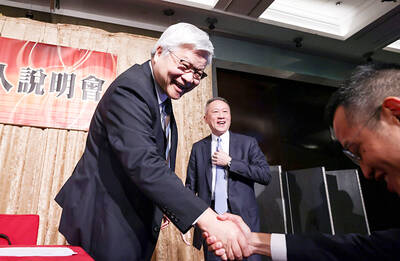China yesterday set a modest annual economic growth target, at above 6 percent, and pledged to create more urban jobs than last year, as the world’s second-biggest economy planned a careful course out of a year disrupted by COVID-19.
Last year, for the first time since 2002, China dropped a GDP growth target from the work report given by the Chinese premier, because the pandemic devastated its economy. China’s GDP expanded 2.3 percent last year, the weakest in 44 years, but making it the only major economy to report growth.
“As a general target, China’s growth rate has been set at over 6 percent for this year,” Premier Li Keqiang (李克強) said in his work report this year. “In setting this target, we have taken into account the recovery of economic activity.”
However, the target for this year is significantly below the consensus of analysts, who expect growth could beat 8 percent this year, which caused Chinese shares to fall.
China’s conservative growth target reflects a public effort to demonstrate a return to economic stability after last year’s COVID-19 upheaval, while keeping a lid on appetite for debt and risk, policy advisers said.
“It’s obvious this year’s growth will be over 6 percent. The purpose is to tell people that we should focus on higher-quality growth,” said Yao Jingyuan (姚景源), an adviser to China’s Cabinet.
The low GDP target means the government is not likely to tighten policy and planners would have more room to push reforms, as many parts of the economy are still struggling.
This year, China aims to create more than 11 million new urban jobs, up from last year’s goal of more than 9 million and in line with recent years, Li said in his report, delivered at the opening of this year’s Chinese National People’s Congress.
The government is targeting a budget deficit this year of about 3.2 percent of GDP, less than its goal of more than 3.6 percent last year, although giving room to fund infrastructure and aid small firms.
Iris Pang (彭藹嬈), chief economist for Greater China at ING, said that continued fiscal latitude is a more meaningful target than the growth target.
“The very low GDP growth target is like there is no target at all because the consensus is 8 percent and my forecast is 7 percent,” Pang told Reuters.
“I believe that most of the money will be used for technology research and development, and continue to provide some buffer for job stability just in case COVID-19 has a comeback,” she added.

Stephen Garrett, a 27-year-old graduate student, always thought he would study in China, but first the country’s restrictive COVID-19 policies made it nearly impossible and now he has other concerns. The cost is one deterrent, but Garrett is more worried about restrictions on academic freedom and the personal risk of being stranded in China. He is not alone. Only about 700 American students are studying at Chinese universities, down from a peak of nearly 25,000 a decade ago, while there are nearly 300,000 Chinese students at US schools. Some young Americans are discouraged from investing their time in China by what they see

Taiwan Semiconductor Manufacturing Co (TSMC, 台積電), the world’s largest contract chipmaker, yesterday reported record sales for the first quarter, which analysts attributed to solid demand for emerging technologies. Consolidated revenue totaled NT$592.64 billion (US$18.51 billion) in the January-to-March period, up 16.5 percent from a year earlier, but down 5.26 percent from the previous quarter, TSMC said in a statement. The first-quarter revenue beat analysts’ average projection of NT$579.5 billion, Bloomberg News reported. That performance lends weight to expectations that the world’s most valuable chipmaker would return to solid growth this year after weathering a post-COVID-19-pandemic cratering of smartphone and computer sales. TSMC is budgeting

US CONSCULTANT: The US Department of Commerce’s Ursula Burns is a rarely seen US government consultant to be put forward to sit on the board, nominated as an independent director Taiwan Semiconductor Manufacturing Co (TSMC, 台積電), the world’s largest contract chipmaker, yesterday nominated 10 candidates for its new board of directors, including Ursula Burns from the US Department of Commerce. It is rare that TSMC has nominated a US government consultant to sit on its board. Burns was nominated as one of seven independent directors. She is vice chair of the department’s Advisory Council on Supply Chain Competitiveness. Burns is to stand for election at TSMC’s annual shareholders’ meeting on June 4 along with the rest of the candidates. TSMC chairman Mark Liu (劉德音) was not on the list after in December last

FIRST FORAY: The maker of EUV pods said it plans to begin the construction of the plant later this year, with mass production expected to start next year Gudeng Precision Industrial Co (家登精密), the sole extreme ultraviolet (EUV) pod supplier to Taiwan Semiconductor Manufacturing Co (TSMC, 台積電), plans to build a plant in Japan in an effort to help customers boost supply chain resiliency, it said yesterday. The NT$500 million (US$15.52 million) investment is a response to requests by key customers to build capacity outside Taiwan and China amid escalating geopolitical tensions, it said. The plant would be built in Fukuoka Prefecture’s Kurume, which is about a one-hour drive from TSMC’s fab in Kumamoto Prefecture’s Kikuyo, Gudeng said. Gudeng plans to begin the construction of its first overseas plant later this